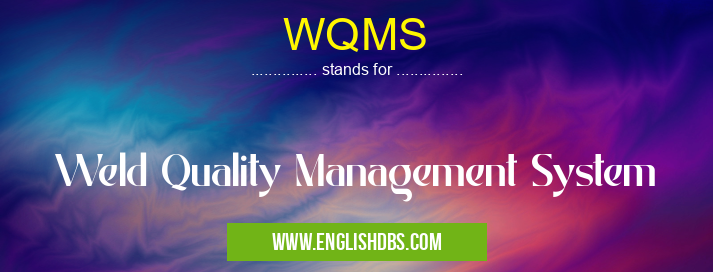What does WQMS mean in MANAGEMENT
WQMS stands for Weld Quality Management System. It is a comprehensive system designed to ensure the quality and integrity of welds in various industries, including manufacturing, construction, and aerospace. The primary objective of a WQMS is to establish and maintain standardized processes for welding operations, ensuring that welds meet specific quality requirements and industry standards. By implementing a WQMS, organizations can enhance weld quality, minimize defects, and improve overall safety and productivity.

WQMS meaning in Management in Business
WQMS mostly used in an acronym Management in Category Business that means Weld Quality Management System
Shorthand: WQMS,
Full Form: Weld Quality Management System
For more information of "Weld Quality Management System", see the section below.
» Business » Management
Key Components of a WQMS
A WQMS typically encompasses several key components:
- Welding Procedures and Specifications: Establishing clear and detailed welding procedures that specify the required welding techniques, materials, equipment, and quality standards.
- Welder Qualification and Certification: Ensuring that welders are qualified and certified based on industry standards and the specific welding processes they perform.
- Material Control and Traceability: Implementing systems to control the procurement, storage, and traceability of welding materials to ensure their quality and integrity.
- Non-Destructive Testing (NDT): Utilizing NDT techniques to inspect and evaluate welds for defects and ensure their compliance with quality standards.
- Quality Control and Inspection: Establishing regular quality control checks and inspections to monitor weld quality and identify any potential issues.
- Continuous Improvement: Implementing processes for continuous improvement, including regular reviews, audits, and feedback mechanisms, to enhance the effectiveness of the WQMS.
Benefits of Implementing a WQMS
Organizations that implement a WQMS can reap several benefits, including:
- Improved Weld Quality: Ensures consistent weld quality by establishing standardized processes and procedures.
- Reduced Defects and Rework: Minimizes weld defects and the associated costs of rework and repairs.
- Enhanced Safety: Promotes a safe working environment by establishing safe welding practices and reducing the risk of weld-related accidents.
- Increased Productivity: Streamlines welding operations and improves efficiency by eliminating unnecessary delays and rework.
- Compliance with Industry Standards: Demonstrates compliance with industry standards and regulations, enhancing customer satisfaction and reputation.
Essential Questions and Answers on Weld Quality Management System in "BUSINESS»MANAGEMENT"
What is WQMS?
WQMS (Weld Quality Management System) is a comprehensive system designed to ensure the quality of welding processes and products. It involves establishing and implementing policies, procedures, and controls to monitor and maintain the quality of welding operations.
What are the benefits of using WQMS?
Implementing WQMS provides numerous benefits, including:
- Improved weld quality and reliability
- Reduced welding defects and rework
- Increased productivity and efficiency
- Enhanced compliance with industry standards and regulations
- Improved customer satisfaction
What are the key components of WQMS?
WQMS typically includes the following key components:
- Welding procedures and specifications
- Welder qualification and training
- Welding equipment maintenance and calibration
- Inspection and testing procedures
- Quality control and assurance processes
- Non-destructive testing methods
How can WQMS be implemented in a welding organization?
Implementing WQMS involves several steps:
- Establishing a quality policy
- Developing and documenting welding procedures
- Qualifying and training welders
- Maintaining and calibrating welding equipment
- Implementing inspection and testing procedures
- Establishing quality control and assurance processes
- Monitoring and reviewing WQMS effectiveness
How does WQMS ensure weld quality?
WQMS ensures weld quality through various mechanisms:
- By establishing clear welding procedures and specifications, it provides welders with detailed instructions and guidelines.
- Welder qualification and training ensure that welders possess the necessary skills and knowledge to perform high-quality welding.
- Maintenance and calibration of equipment prevent equipment malfunctions that could affect weld quality.
- Inspection and testing procedures identify and address any defects or non-conformances in welds.
- Quality control and assurance processes monitor and evaluate weld quality throughout the welding process.
Final Words: A WQMS is an essential tool for organizations seeking to achieve and maintain high-quality welds. By implementing a comprehensive WQMS, organizations can ensure the integrity and reliability of their welded products, reduce defects, improve productivity, and enhance safety. The benefits of a well-implemented WQMS extend beyond immediate cost savings and include long-term improvements in quality, efficiency, and customer satisfaction.
